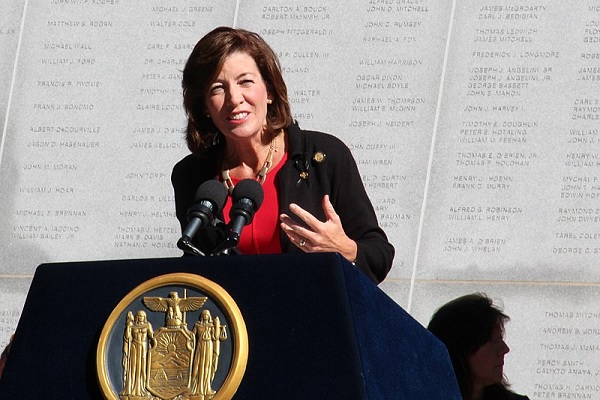
–>
April 13, 2023
The indomitable Betsy McCaughey has called out the latest ugly manifestation of “diversity, inclusion, and equity” the drive to destroy the suburbs. The Biden administration and Democrat-controlled legislatures in several states have taken the lead in this effort. In New York State, Governor Kathy Hochul, as part of the state budget, has advanced a so-called Housing Compact that would eliminate local control and single family zoning.
‘); googletag.cmd.push(function () { googletag.display(‘div-gpt-ad-1609268089992-0’); }); }
Hochul’s plan would require that high-rise “affordable” (read: low-income, taxpayer-subsidized) housing be constructed close to each sleepy village train station — mostly a few miles apart — on Metro North and the Long Island Railroad. If the affected communities fail to do so “voluntarily,” the state will have the power to override local zoning. Those who fail to applaud this combined coup by warriors for social justice and real estate interests are, you guessed it, racist.
Suburban homeowners, Democrats as well as Republicans, are beginning to awaken to the deadly threat these proposals pose to their way of life. What is largely overlooked is that this is a repeat of a similar effort in 1972 about which I wrote at the time (“Housing Controversy in Westchester,” Congress Biweekly, November 10, 1972 and December 22, 1972). Believe it or not, the effort to overthrow zoning was then spearheaded by Republicans — with New York’s Westchester County selected to pioneer the program.
On June 20, 1972, the New York State Urban Development Corporation announced that it was overriding local zoning to create a variety of low- and moderate-income housing developments in nine, for the most part rural, Westchester communities. Reminiscent of the emotional reaction to the death of George Floyd, the UDC had been given zoning override power by a hitherto balky state Legislature the day after the murder of Martin Luther King. Republican governor Nelson Rockefeller, in a burst of virtue-signaling, argued that this was the best tribute the Legislature could give the slain civil rights leader. When rationality returned, efforts by the state Legislature to take away the override power were vetoed by Rockefeller.
‘); googletag.cmd.push(function () { googletag.display(‘div-gpt-ad-1609270365559-0’); }); }
On a national level, Nixon’s Department of Housing and Urban Development, headed by George Romney, joined in the pressure from another angle. It introduced project selection criteria reducing the availability of federal funds for low-income housing in areas with existing large minority populations. This in turn led to protests from inner-city communities arguing that the new guidelines would make it impossible to rehabilitate their areas.
The only clear winners in these proposals were real estate investors. The UDC calculated that investors needed to put up only 5% of the cost of the projects. An investor in the 50% bracket could recoup his entire investment in a year; an investor in the 70% bracket needed only three months. For banks, building contractors, and real estate middlemen of all varieties, it had the potential to be the biggest gravy train of the decade.
Needless to say, proponents did not mention the profit motive (one site had been sold to UDC at a figure eight times its market price a few months earlier). The slogan UDC used to describe the program was “Fair Share,” underlining the view that all communities have the responsibility to assume a share of the problems of social disorganization concentrated in urban centers. In part, this reflected ressentiment: a New York Times op-ed entitled “A Pox on You, Riverdale” asked why some communities should “escape” the problems others suffer. There was also a high-minded hope that population transfers would “uplift” those who had been left behind.
A flood of protests by the affected communities derailed the politicians’ overreach. An organization called United Towns for Home Rule sprang up, which decried the “administrative despotism” of a group accountable to no elected body. The slogan that brought the audience roaring to its feet at a July 20 meeting was “People’s Power,” a cry thus far unfamiliar in the staid establishment circles of the nine prosperous Westchester communities under immediate threat.
What are the chances that this time, 51 years later, legislation to override zoning in New York will be successful? The current triumph of Diversity, Inclusion, and Equity throughout our institutions, the belief in systemic racism, the near deification of the poor — all speak to a climate much more susceptible to supporting zoning overrides in the name of “social justice” than existed fifty years ago.
Nonetheless, the likelihood is that this effort will fail for the same reason the earlier one did. The American Dream includes the notion that by working and “getting ahead,” you can move up in the world, which involves finding a more attractive home and neighborhood in which to live, educate, and raise your family. This legislation tells Americans there are no rewards for mobility because any time, by fiat, some bureaucracy can alter the character of your community.
‘); googletag.cmd.push(function () { googletag.display(‘div-gpt-ad-1609268078422-0’); }); } if (publir_show_ads) { document.write(“
Whether Republicans or Democrats, suburban householders are unwilling to see community zoning decisions and local master planning become meaningless exercises and to see the value of their greatest investment potentially plummet at far-off bureaucratic whims. That means their representatives in the state Legislature, however “progressive” their personal views, will fear defeat at the next election if they don’t oppose Governor Hochul’s “death to the suburbs” legislative agenda.

Image: Kathy Hochul. Credit: NYS Funeral Directors Association via Wikimedia Commons, CC BY 2.0 (cropped).
<!– if(page_width_onload <= 479) { document.write("
“); googletag.cmd.push(function() { googletag.display(‘div-gpt-ad-1345489840937-4’); }); } –> If you experience technical problems, please write to [email protected]
FOLLOW US ON
<!–
–>
<!– _qoptions={ qacct:”p-9bKF-NgTuSFM6″ }; ![]() –> <!—-> <!– var addthis_share = { email_template: “new_template” } –>
–> <!—-> <!– var addthis_share = { email_template: “new_template” } –>






